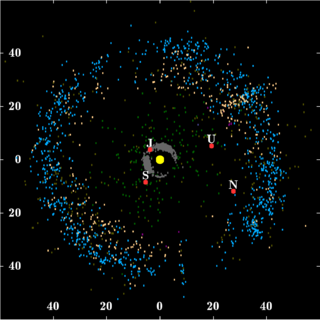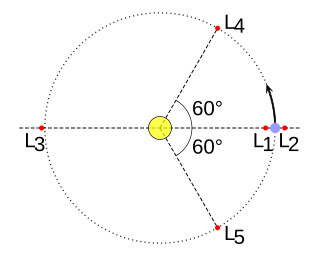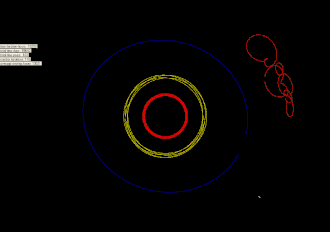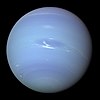
The Kuiper belt is a circumstellar disc in the outer Solar System, extending from the orbit of Neptune at 30 astronomical units (AU) to approximately 50 AU from the Sun. It is similar to the asteroid belt, but is far larger—20 times as wide and 20–200 times as massive. Like the asteroid belt, it consists mainly of small bodies or remnants from when the Solar System formed. While many asteroids are composed primarily of rock and metal, most Kuiper belt objects are composed largely of frozen volatiles, such as methane, ammonia, and water. The Kuiper belt is home to most of the objects that astronomers generally accept as dwarf planets: Orcus, Pluto, Haumea, Quaoar, and Makemake. Some of the Solar System's moons, such as Neptune's Triton and Saturn's Phoebe, may have originated in the region.

The Jupiter trojans, commonly called trojan asteroids or simply trojans, are a large group of asteroids that share the planet Jupiter's orbit around the Sun. Relative to Jupiter, each trojan librates around one of Jupiter's stable Lagrange points: either L4, existing 60° ahead of the planet in its orbit, or L5, 60° behind. Jupiter trojans are distributed in two elongated, curved regions around these Lagrangian points with an average semi-major axis of about 5.2 AU.

(612243) 2001 QR322, prov. designation: 2001 QR322, is a minor planet and the first Neptune trojan discovered, by American astronomer Marc Buie of the Deep Ecliptic Survey at Cerro Tololo Observatory in Chile on 21 August 2001. It orbits ahead of Neptune at its L4 Lagrangian point and measures approximately 132 kilometers (82 miles) in diameter.
In astronomy, a resonant trans-Neptunian object is a trans-Neptunian object (TNO) in mean-motion orbital resonance with Neptune. The orbital periods of the resonant objects are in a simple integer relations with the period of Neptune, e.g. 1:2, 2:3, etc. Resonant TNOs can be either part of the main Kuiper belt population, or the more distant scattered disc population.

The scattered disc (or scattered disk) is a distant circumstellar disc in the Solar System that is sparsely populated by icy small Solar System bodies, which are a subset of the broader family of trans-Neptunian objects. The scattered-disc objects (SDOs) have orbital eccentricities ranging as high as 0.8, inclinations as high as 40°, and perihelia greater than 30 astronomical units (4.5×109 km; 2.8×109 mi). These extreme orbits are thought to be the result of gravitational "scattering" by the gas giants, and the objects continue to be subject to perturbation by the planet Neptune.
2005 TN53 is an inclined Neptune trojan leading Neptune's orbit in the outer Solar System, approximately 80 kilometers in diameter. It was first observed on 7 October 2005, by American astronomers Scott Sheppard and Chad Trujillo at Las Campanas Observatory in the Atacama desert of Chile. It was the third such body to be discovered, and the first with a significant orbital inclination, which showed that the population as a whole is very dynamically excited.
385695 Clete, provisional designation 2005 TO74, is a Neptune trojan, co-orbital with the ice giant Neptune, approximately 97 kilometers (60 miles) in diameter. It was named after Clete, one of the Amazons from Greek mythology. The minor planet was discovered on 8 October 2005, by American astronomers Scott Sheppard and Chad Trujillo at Las Campanas Observatory in Chile. 23 known Neptune trojans have already been discovered.

In astronomy, a trojan is a small celestial body (mostly asteroids) that shares the orbit of a larger body, remaining in a stable orbit approximately 60° ahead of or behind the main body near one of its Lagrangian points L4 and L5. Trojans can share the orbits of planets or of large moons.
In astronomy, a co-orbital configuration is a configuration of two or more astronomical objects orbiting at the same, or very similar, distance from their primary, i.e. they are in a 1:1 mean-motion resonance..
(309239) 2007 RW10, provisionally known as 2007 RW10, is a temporary quasi-satellite of Neptune. Observed from Neptune, it would appear to go around it during one Neptunian year but it actually orbits the Sun, not Neptune.

The Nicemodel is a scenario for the dynamical evolution of the Solar System. It is named for the location of the Côte d'Azur Observatory—where it was initially developed in 2005—in Nice, France. It proposes the migration of the giant planets from an initial compact configuration into their present positions, long after the dissipation of the initial protoplanetary disk. In this way, it differs from earlier models of the Solar System's formation. This planetary migration is used in dynamical simulations of the Solar System to explain historical events including the Late Heavy Bombardment of the inner Solar System, the formation of the Oort cloud, and the existence of populations of small Solar System bodies such as the Kuiper belt, the Neptune and Jupiter trojans, and the numerous resonant trans-Neptunian objects dominated by Neptune.
2008 LC18 is a Neptune trojan first observed on 7 June 2008 by American astronomers Scott Sheppard and Chad Trujillo using the Subaru telescope at Mauna Kea Observatories on Hawaii, United States. It was the first object found in Neptune's trailing L5 Lagrangian point and measures approximately 100 kilometers in diameter.
2004 KV18 is an eccentric Neptune trojan trailing Neptune's orbit in the outer Solar System, approximately 70 kilometers in diameter. It was first observed on 24 May 2004, by astronomers at the Mauna Kea Observatories on Hawaii, United States. It was the eighth Neptune trojan identified and the second in Neptune's L5 Lagrangian point.
2011 HM102 is the ninth Neptune trojan discovered. It was first observed on 29 April 2011, during the New Horizons KBO Search (268) using the Magellan II (Clay) Telescope at Las Campanas Observatory in Chile. It has the same orbital period as Neptune and orbits at the L5 Lagrangian point about 60° backwards of Neptune.

(316179) 2010 EN65 is a trans-Neptunian object orbiting the Sun. However, with a semi-major axis of 30.8 AU, the object is actually a jumping Neptune trojan, co-orbital with Neptune, as the giant planet has a similar semi-major axis of 30.1 AU. The body is jumping from the Lagrangian point L4 into L5 via L3. As of 2016, it is 54 AU from Neptune. By 2070, it will be 69 AU from Neptune.

Asteroid 2011 QF99 is a minor planet from the outer Solar System and the first known Uranus trojan to be discovered. It measures approximately 60 kilometers (37 miles) in diameter, assuming an albedo of 0.05. It was first observed 29 August 2011 during a deep survey of trans-Neptunian objects conducted with the Canada–France–Hawaii Telescope, but its identification as Uranian trojan was not announced until 2013.
The jumping-Jupiter scenario specifies an evolution of giant-planet migration described by the Nice model, in which an ice giant is scattered inward by Saturn and outward by Jupiter, causing their semi-major axes to jump, quickly separating their orbits. The jumping-Jupiter scenario was proposed by Ramon Brasser, Alessandro Morbidelli, Rodney Gomes, Kleomenis Tsiganis, and Harold Levison after their studies revealed that the smooth divergent migration of Jupiter and Saturn resulted in an inner Solar System significantly different from the current Solar System. During this migration secular resonances swept through the inner Solar System exciting the orbits of the terrestrial planets and the asteroids, leaving the planets' orbits too eccentric, and the asteroid belt with too many high-inclination objects. The jumps in the semi-major axes of Jupiter and Saturn described in the jumping-Jupiter scenario can allow these resonances to quickly cross the inner Solar System without altering orbits excessively, although the terrestrial planets remain sensitive to its passage.
12929 Periboea, provisional designation: 1999 TZ1, is a dark Jupiter trojan from the Trojan camp, approximately 54 kilometers (34 miles) in diameter. It was discovered on 2 October 1999, by American astronomer Charles W. Juels at the Fountain Hills Observatory in Arizona. Originally considered a centaur, this now re-classified Jovian asteroid has a rotation period of 9.3 hours and belongs to the 80 largest Jupiter trojans. It was named from Greek mythology after Periboea, mother of Pelagon by the river-god Axius.










